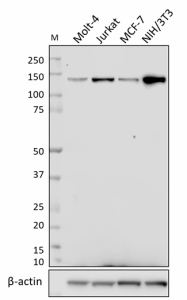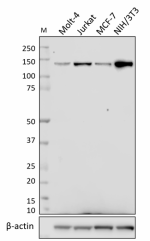- Clone
- W15202A (See other available formats)
- Regulatory Status
- RUO
- Other Names
- Histone deacetylase 5 (HD5), Antigen NY-CO-9, KIAA0600
- Isotype
- Rat IgG2b, κ
- Ave. Rating
- Submit a Review
- Product Citations
- publications

-

Whole cell extracts (15 µg total protein) from Molt-4, Jurkat, MCF-7, and NIH/3T3 were resolved by 4-12% Bis-Tris gel electrophoresis, transferred to a nitrocellulose membrane, and probed with 0.5 µg/mL (1:1000 dilution) of Purified anti-HDAC5 Antibody, clone W15202A, overnight at 4°C. Proteins were visualized by chemiluminescence detection using HRP goat anti-rat IgG Antibody (Cat. No. 405405) at a 1:3000 dilution. Direct-Blot™ HRP anti-β-actin Antibody (Cat. No. 664804) was used as a loading control at a 1:10000 dilution (lower). Lane M: Molecular Weight marker.
| Cat # | Size | Price | Quantity Check Availability | Save | ||
|---|---|---|---|---|---|---|
| 693401 | 25 µg | 101 CHF | ||||
| 693402 | 100 µg | 253 CHF | ||||
Histone deacetylases (HDACs) are a family of enzymes capable of regulating acetylation level of histones and non-histone proteins. HDACs have been classified into four classes (class I, II, III, and IV) based on their homology with yeast HDACs. HDAC5 is a member of class IIa HDACs, which contain N-terminal extensions with 14-3-3 binding sites. Phosphorylation of HDAC5 on Ser259 and Ser498 leads to association with 14-3-3 proteins and export from the nucleus. HDAC5 has been suggested to participate in various cellular activities, such as cell proliferation, cell cycle progression, apoptosis, neuronal repair, synoviocyte activation, and myoblast differentiation. Aberrant expression of HDAC5 has been shown to be associated with tumor progression and poor prognosis in cancer patients.
Product DetailsProduct Details
- Verified Reactivity
- Human, Mouse
- Antibody Type
- Monoclonal
- Host Species
- Rat
- Immunogen
- Partial human HDAC5 recombinant protein (320-480 a.a.) expressed in E. coli.
- Formulation
- Phosphate-buffered solution, pH 7.2, containing 0.09% sodium azide.
- Preparation
- The antibody was purified by affinity chromatography.
- Concentration
- 0.5 mg/mL
- Storage & Handling
- The antibody solution should be stored undiluted between 2°C and 8°C.
- Application
-
WB - Quality tested
- Recommended Usage
-
Each lot of this antibody is quality control tested by Western blotting. For Western blotting, the suggested use of this reagent is 0.5 - 2.0 µg per mL. It is recommended that the reagent be titrated for optimal performance for each application.
- RRID
-
AB_2632835 (BioLegend Cat. No. 693401)
AB_2632835 (BioLegend Cat. No. 693402)
Antigen Details
- Structure
- 1122 amino acids with a predicted molecular weight of 122 kD and observed of approximately 140 kD. Contains a histone deacetylation domain responsible for the removal of acetyl group on the side chain of lysine residue.
- Distribution
-
Nucleus and cytoplasm.
- Function
- HDAC5 is a class II histone deacetylase and plays important roles in cell proliferation, differentiation, apoptosis, and tumor progression.
- Interaction
- Interacts with AHRR, BAHD1, BCOR, HDAC7, HDAC9, CTBP1, MEF2C, NCOR2, NRIP1, PHB2, 14-3-3, BCL6, DDIT3/CHOP, GRK5, KDM5B, MYOCD, and EP300.
- Biology Area
- Cell Biology, Chromatin Remodeling/Epigenetics
- Antigen References
-
1. Xiao H, et al. 2016. Int. J. Cancer 138:2477.
2. Chen S, et al. 2015. Cell Cycle 14:2520.
3. Cho Y, et al. 2013. Cell. 155:894.
4. Kim SS, et al. 2013. Mol. Cell. 52:289.
5. Cho Y, et al. 2012. EMBO J. 31:3063.
6. Watamoto K, et al. 2003. Oncogene. 22:9176. - Gene ID
- 10014 View all products for this Gene ID
- UniProt
- View information about HDAC5 on UniProt.org
Related Pages & Pathways
Pages
Other Formats
View All HDAC5 Reagents Request Custom Conjugation| Description | Clone | Applications |
|---|---|---|
| Purified anti-HDAC5 | W15202A | WB |
Compare Data Across All Formats
This data display is provided for general comparisons between formats.
Your actual data may vary due to variations in samples, target cells, instruments and their settings, staining conditions, and other factors.
If you need assistance with selecting the best format contact our expert technical support team.
-
Purified anti-HDAC5

Whole cell extracts (15 µg total protein) from Molt-4, Jurka...
 Login / Register
Login / Register 







Follow Us